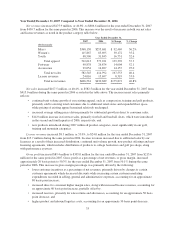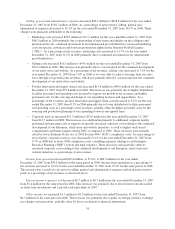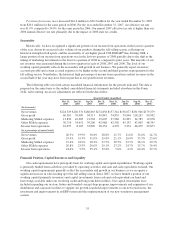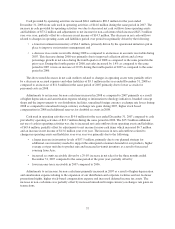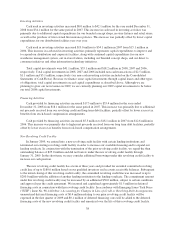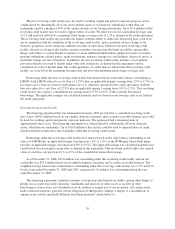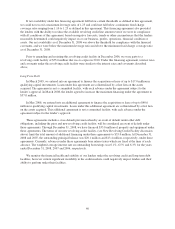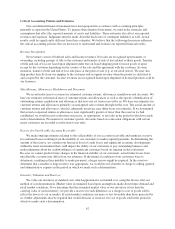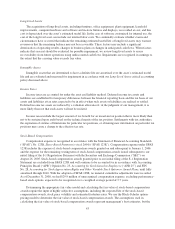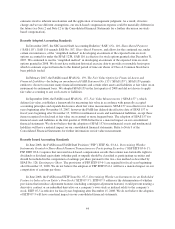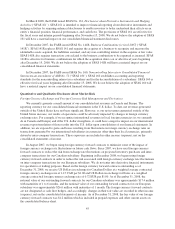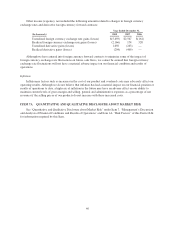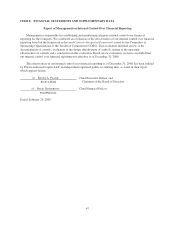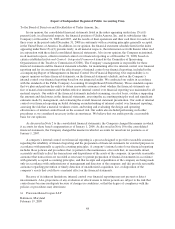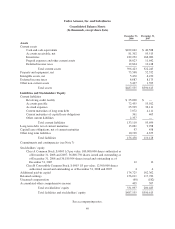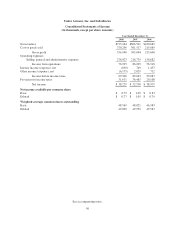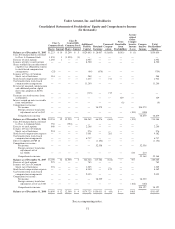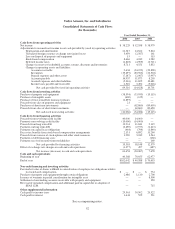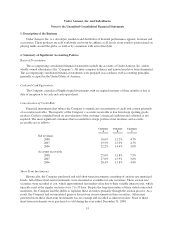Under Armour 2008 Annual Report Download - page 51
Download and view the complete annual report
Please find page 51 of the 2008 Under Armour annual report below. You can navigate through the pages in the report by either clicking on the pages listed below, or by using the keyword search tool below to find specific information within the annual report.Long-Lived Assets
The acquisition of long-lived assets, including furniture, office equipment, plant equipment, leasehold
improvements, computer hardware and software and in-store fixtures and displays, is recorded at cost, and this
cost is depreciated over the asset’s estimated useful life. In the case of software customized for internal use, the
cost of the long-lived asset can include our internal labor costs. We continually evaluate whether events and
circumstances have occurred that indicate the remaining estimated useful life of long-lived assets may warrant
revision or that the remaining balance may not be recoverable. These factors may include a significant
deterioration of operating results, changes in business plans or changes in anticipated cash flows. When factors
indicate that an asset should be evaluated for possible impairment, we review long-lived assets to assess
recoverability from future operations using undiscounted cash flows. Impairments are recognized in earnings to
the extent that the carrying value exceeds fair value.
Intangible Assets
Intangible assets that are determined to have a definite life are amortized over the asset’s estimated useful
life and are evaluated and measured for impairment in accordance with our Long-Lived Assets critical accounting
policy discussed above.
Income Taxes
Income taxes are accounted for under the asset and liability method. Deferred income tax assets and
liabilities are established for temporary differences between the financial reporting basis and the tax basis of our
assets and liabilities at tax rates expected to be in effect when such assets or liabilities are realized or settled.
Deferred income tax assets are reduced by a valuation allowance if, in the judgment of our management, it is
more likely than not that such assets will not be realized.
Income taxes include the largest amount of tax benefit for an uncertain tax position that is more likely than
not to be sustained upon audit based on the technical merits of the tax position. Settlements with tax authorities,
the expiration of statutes of limitations for particular tax positions, or obtaining new information on particular tax
positions may cause a change to the effective tax rate.
Stock-Based Compensation
Compensation expense is recognized in accordance with the Statement of Financial Accounting Standards
(“SFAS”) No. 123R, Share-Based Payment (revised 2004) (“SFAS 123R”). Compensation expense under SFAS
123R includes the expense of stock-based compensation awards granted on and subsequent to January 1, 2006
and the expense for the remaining vesting term of stock-based compensation awards issued subsequent to our
initial filing of the S-1 Registration Statement with the Securities and Exchange Commission (“SEC”) on
August 26, 2005. Stock-based compensation awards granted prior to our initial filing of the S-1 Registration
Statement are excluded from SFAS 123R and will continue to be accounted for in accordance with Accounting
Principles Board (“APB”) Opinion No. 25, Accounting for Stock Issued to Employees (“APB 25”) and FIN
No. 28, Accounting for Stock Appreciation Rights and Other Variable Stock Option or Award Plans, until fully
amortized through 2010. With the adoption of SFAS 123R, no material cumulative adjustments were recorded.
As of December 31, 2008, we had $29.9 million of unrecognized compensation expense, excluding performance-
based stock options, expected to be recognized over a weighted average period of 3.7 years.
Determining the appropriate fair value model and calculating the fair value of stock-based compensation
awards require the input of highly subjective assumptions, including the expected life of the stock-based
compensation awards, stock price volatility and estimated forfeiture rates. We use the Black-Scholes option-
pricing model to determine the fair value of stock-based compensation awards. The assumptions used in
calculating the fair value of stock-based compensation awards represent management’s best estimates, but the
43


